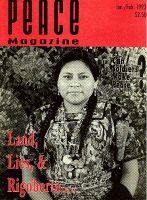
Peace Magazine Jan-Feb 1993, page 16. Some rights reserved.
Search for other articles by Hanna Newcombe here
Do we need world government to prevent mutual killing? Or are we basically noble savages? Can peace thinking reconcile these opposing philosophies?
The peace movement has generated many proposals over the years, but when we focus only on long-range, fundamental proposals, we find that there are only basically two: one is world federal government and the other is principled nonviolence.
The proponents of these two alternatives to the present war system have not always been on friendly terms. The pacifist wing of the peace movement has faulted world government for its continued reliance on violence, i.e. enforcing world law against international criminals, or U.N. peacekeeping forces using weapons, even if rarely. The internationalist wing of the peace movement saw nonviolence as offering no answers to the problem of deliberate evil-doers. This leaves us wondering if the two approaches could be combined so as to complement each other.
Taken to extremes, each approach has definite draw-backs. At its worst, the world government proposals are too centralizing, even if federal structure is postulated. They make Hobbesian assumptions about human nature, and extend them to the international arena: just as individuals need a strong government to prevent them from mutual killing and stealing, so do nations. The Hobbesian solution is adopted, giving the government a monopoly of violence. Some schemes suggest that nuclear weapons should be transferred to the world government, while individual nations are disarmed. This begs the question of tyranny-what if those centralized weapons of mass destruction are used to terrorize everybody into obeying a tyrant? The world government model at its worst is too state-oriented, ignoring other actors on the world stage, such as people's organizations, churches, or multinational corporations.
The nonviolence movement also has drawbacks. It tends to be anarchist, as does the Green movement. While "small" may be "beautiful," global problems still require global solutions. Radioactive contamination (e.g. from the Chernobyl accident) acid rain, and global warming do not respect national borders, or even the borders of bio-regions. The movement's model of human nature tends to be in the "noble savage" tradition of Rousseau: people would get along just fine if governments left them alone. Human nature is likely to be somewhere between the conceptions of Hobbes and Rousseau. The prohibition of violence is sometimes too extreme; a pilot gone crazy and about to bomb Russia and trigger nuclear war should not be shot down, according to this absolutist view. Also, avoidance of verbal and psychological violence as well as physical violence would leave us almost unable to communicate in conflict situations. No manipulation or coercion? This seems equally unrealistic; we all do it all the time, though usually without physical violence. Moreover, in practice the nonviolent movement also manipulates and coerces others. While the world-government movement is too statist, the nonviolence movement is too individualist. Again, a happy balance seems to be called for.
We must remember that the draw-backs of the world federalist and nonviolent peace movements sketched above deliberately concentrate on the extreme forms of each doctrine, not the much milder, less dogmatic positions usually put forward by their proponents in practice. These milder positions are much more easily reconciled. They would also have fewer disadvantages, the rough edges being removed, so to speak. The convergence of the best aspects of both approaches could follow the principles outlined below.
1. To avoid both too much and too little centralization:
(a) use the principle of subsidiarity: solve problems at the lowest level at which there are no significant external effects.
(b) aim at constructing a multi-level world, going from the individual to neighbourhood government, municipal to provincial to national to continental, and finally to global government, in six steps from person to planet.
2. Human nature should be initially trusted, or given the benefit of the doubt, but means must exist to deal with cases where this basic trust is proved to be unjustified. We spontaneously do this (those of us who are neither paranoid nor gullible). Social life depends mainly on mutual trust, not on the police, but the police must be there as a backup in case it is needed.
3. Nations should be disarmed down to police levels-i.e. conventional as well as nuclear, chemical, and biological disarmament. The world government should have only a lightly armed World Police Force, certainly no weapons of mass destruction.
4. To attain a dynamic peace defined as a world order in which conflicts are resolved justly, nonviolently, and creatively, all social units must be taken into account: individuals, states, the world government, and all stages and structures in between and across national borders, as well as multinational corporations, non-state actors, and non-governmental organizations.
These four points are summarized in the Table. But something additional must also be stated, about the complementarity of the world government and nonviolence approaches.
5. In normal operation, conflicts will be resolved through negotiation, mediation, arbitration, adjudication, voting in elections and referenda, etc. However, if this fails, or if the world government shows signs of becoming unjust or oppressive, citizens would have the right to organize for extra-legal nonviolent direct action. Moreover, in order to keep this option well-furbished and ready, citizens should be trained in the effective use of nonviolent methods. However civil disobedience of this type should be used rarely, only as a last resort.
Would such a convergence of peace models be acceptable to most of the peace movement? It has a good chance of being so. The larger question of acceptability to the general public and the leaders can be answered only by experience. Let us give it a chance.
Hanna Newcombe works with the Peace Research Institute Dundas.

Peace Magazine Jan-Feb 1993, page 16. Some rights reserved.
Search for other articles by Hanna Newcombe here